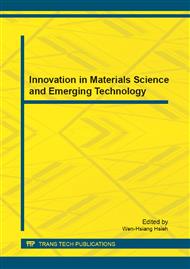[1]
W. Ritter: Schweizerische Bauzeitung Vol. 33 (1899), p.59.
Google Scholar
[2]
Mörsch: Der eisenbetonbau: seine theorie und anwendung (Verlag Konrad Wittner, Stuttgart 1912).
Google Scholar
[3]
T. T. C. Hsu and R. R. H. Zhu: ACI Struct. J. Vol. 99 (2002), p.460.
Google Scholar
[4]
J. C. McCormac and J. K. Nelson: Design of Reinforced Concrete (John Wiley 2006).
Google Scholar
[5]
J.B. Mander, M.J.N. Priestley, R. Park: J. Struct. Eng. 114, 1804 (1988).
Google Scholar
[6]
ACI Committee 318: Building Code Requirements for Structural Concrete (ACI 318-05) and Commentary (ACI 318R-05) (American Concrete Institute, Farmington Hills 2005).
DOI: 10.1061/(asce)1076-0431(1996)2:3(120.3)
Google Scholar
[7]
C. L. Wu, S. J. Hwang, Y. S. Yang, and R. S. Su: Shake Table Tests on Reinforced Concrete Short Columns Failing in Shear, Report No. NCREE-07-033 (National Center for Research on Earthquake Engineering 2007).
Google Scholar
[8]
K.C. Chang, F.S. Chung: Seismic retrofit study of RC columns lap-spliced at plastic hinge zone (National Center for Research on Earthquake Engineering, Taiwan 2000).
Google Scholar
[9]
K.C. Chang, H.F. Chang: Seismic analysis of reinforced concrete columns of bridge and research about retrofit of FRP (National Center for Research on Earthquake Engineering, Taiwan 1999).
Google Scholar
[10]
Y. Ryu, T. Nakamura, M. Yoshimura, in: RC column's loss of axial load carrying capacity, edited by Architectural Institute of Japan, Summaries of Technical Papers of Annual Meeting, Architectural Institute of Japan, Japan (2001).
Google Scholar
[11]
M. Jun, M. Bunno, K. Nagayama, M. Maeda, A. Tasai, M. Nagata, In: An evaluation of residual seismic capacity of reinforced concrete buildings base on the damage of columns part 1. outline of the test and results, edited by Architectural Institute of Japan, Summaries of Technical Papers of Annual Meeting, Architectural Institute of Japan, Japan (2001).
Google Scholar
[12]
K. Nitta, M. Hirabayashi, N. Hanai, H. Umemura, T. Ichinose, In: Size effect on strength deterioration of RC members (part1: outline of experiment), edited by Architectural Institute of Japan, Summaries of Technical Papers of Annual Meeting, Architectural Institute of Japan, Japan (2005).
Google Scholar
[13]
M. Hirabayashi, K. Nishimura, N. Hanai, T. Ichinose, H. Umemura, In: The influence of loading history and reinforcement on strength deterioration of RC members (part1: outline of experiment), edited by Architectural Institute of Japan, Summaries of Technical Papers of Annual Meeting, Architectural Institute of Japan, Japan (2004).
Google Scholar
[14]
M. Hirabayashi, K. Nitta, N. Hanai, H. Umemura, T. Ichinose, In: Size effect on strength deterioration of RC members (part2: results in normal-strength specimens), edited by Architectural Institute of Japan, Summaries of Technical Papers of Annual Meeting, Architectural Institute of Japan, Japan (2005).
Google Scholar


